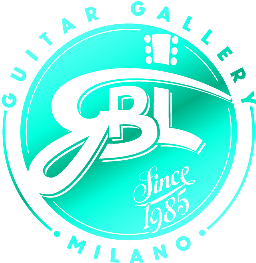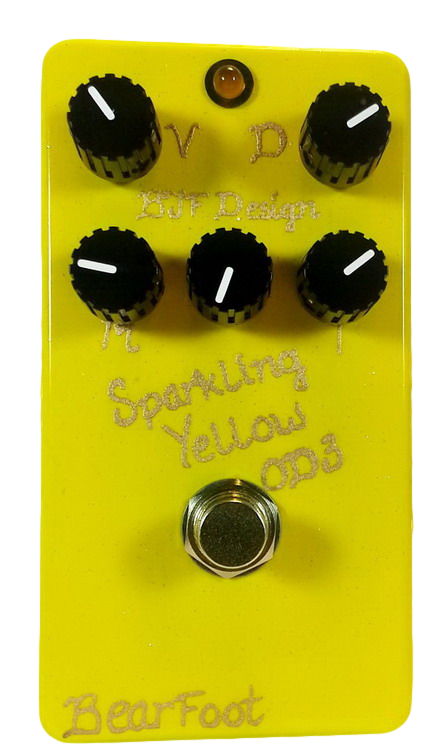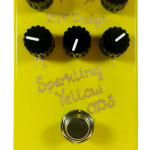Sparkling Yellow Overdrive 3
Video “Manual”
Lance Seymour
Product Description
Can’t decide or need both? The SYOD3 joins the range of the SYOD 1 and 2 with a 2-position rotary switch (5th knob)…the higher the drive setting, the more apparent the difference in the settings.
SYOD3 in “Top 5″ Article from Tone Report Magazine“5 Crucial Fender Overdrives” by Phillip Dodge (August 18, 2014) ~ Excerpts
The Bearfoot Sparkling Yellow Overdrive 3 is the newest member of the Sparkling Yellow family and has a switch for choosing between the voicing of the SYOD1 and the SYOD2. Both settings sound and feel like a vintage amp breaking up into sweet power tube distortion, but the SYOD2 setting is geared more towards going into American-voiced amps, so it’s a great match for your blackface Fender. It’s always hard to quantify, but to my ears, it has the sound and feel of a Tweed Deluxe. As such, it might seem like an odd choice to pair with an amp that Leo Fender designed to be an improvement on the old 1950’s tweed Fenders. But there is a reason Neil Young and countless others still play through Tweed Deluxes—they are the antithesis of the blackface sound: Wild, ragged, unhinged, with a smoother top end and lows that are anything but solid. By using the Sparkling Yellow Overdrive 3, you can have the both ends of the spectrum at the stomp of a switch. The Sparkling Yellow Overdrive 3 does more than just Tweed Deluxe though; with a pre-distortion mid control and a post-distortion treble control, it’s an extremely versatile drive. The mid control is really more of a “low-mids” control and as a result it pushes some bass frequencies as well. Turning it up all of the way brings on a borderline fuzz tone. By following the distortion part of the circuit, the treble control allows you to roll off any harsh upper frequencies. This is especially nice for a Telecaster or Stratocaster bridge pickup. Because of this versatile voicing, the SYO3 melds perfectly into the sound of your amp and it has enough output to push your amp over the edge. Even better, the pedal is very responsive to your input signal. Playing with a lighter touch or rolling back the volume on your guitar serves to clean up the tone just like playing into a real amp.
– See more at: http://tonereport.com/blogs/tone-tips/5-crucial-fender-overdrives#sthash.fxQPRHdt.dpuf
The blackface Fender amplifier of the 1960’s was the result of Leo Fender working tirelessly to create an amp with a bright cutting tone that would stay clean as bands were getting louder and louder. As a result, it has lots of high end and a scooped mid-range. This was a great advancement at the time as it helped guitarists be heard on the crowded band stand. For the modern player, this can be a problem. Those same bright cutting highs can make many overdrive pedals sound less than stellar.
Below is a list of overdrive pedals that will perfectly complement your Blackface Fender amp.
– See more at: http://tonereport.com/blogs/tone-tips/5-crucial-fender-overdrives#sthash.5POjwwJH.x2xACWxo.dpuf
The blackface Fender amplifier of the 1960’s was the result of Leo Fender working tirelessly to create an amp with a bright cutting tone that would stay clean as bands were getting louder and louder. As a result, it has lots of high end and a scooped mid-range. This was a great advancement at the time as it helped guitarists be heard on the crowded band stand. For the modern player, this can be a problem. Those same bright cutting highs can make many overdrive pedals sound less than stellar.
Below is a list of overdrive pedals that will perfectly complement your Blackface Fender amp.
– See more at: http://tonereport.com/blogs/tone-tips/5-crucial-fender-overdrives#sthash.fxQPRHdt.dpuf
The blackface Fender amplifier of the 1960’s was the result of Leo Fender working tirelessly to create an amp with a bright cutting tone that would stay clean as bands were getting louder and louder. As a result, it has lots of high end and a scooped mid-range. This was a great advancement at the time as it helped guitarists be heard on the crowded band stand. For the modern player, this can be a problem. Those same bright cutting highs can make many overdrive pedals sound less than stellar.
Below is a list of overdrive pedals that will perfectly complement your Blackface Fender amp.
– See more at: http://tonereport.com/blogs/tone-tips/5-crucial-fender-overdrives#sthash.fxQPRHdt.dpuf
5 Crucial Fender Overdrives
- By Phillip Dodge
– See more at: http://tonereport.com/blogs/tone-tips/5-crucial-fender-overdrives#sthash.fxQPRHdt.dpuf
The blackface Fender amplifier of the 1960’s was the result of Leo Fender working tirelessly to create an amp with a bright cutting tone that would stay clean as bands were getting louder and louder. As a result, it has lots of high end and a scooped mid-range. This was a great advancement at the time as it helped guitarists be heard on the crowded band stand. For the modern player, this can be a problem. Those same bright cutting highs can make many overdrive pedals sound less than stellar.
Below is a list of overdrive pedals that will perfectly complement your Blackface Fender amp.
– See more at: http://tonereport.com/blogs/tone-tips/5-crucial-fender-overdrives#sthash.fxQPRHdt.dpuf
See our Sparkling Yellow ODs 1 & 2 for further details, demos and reviews!
Reviews from TGP Members
1) GEAR: Fender Greta + 4×8 cab, Blackstar HT1R with and without 4×8…Am Std Tele, late 70s Ibanez HH
“I’m really happy with the pedal. I still feel like I’ve barely scratched the surface of what it has to offer.
I’ve mostly been playing rhythm with it, and mostly in v1 mode (5th knob left). If I want a murky, sagging sort of rhythm sound I reach for my honey bee, but for a crisp, articulate sound the SYOD is awesome. It does a really nice chunky low gain with the mids up a little, treble rolled back to taste and the gain before noon. As you’d expect for a bearfoot / bjfe pedal design, its really responsive to attack and volume. My tele has unbalanced
pickups so the pickup switch is basically a channel switch.
Because I don’t really use much mid or high gain OD (i’d rather use a fuzz) the mode selector is really subtle. For my purposes its like a rhythm / lead switch for the ‘same’ tone.
Really great for home recording. I’m a hack at recording (and playing) and a lot of dirt sounds (amp or pedal) that sound great live sound small and
insipid recorded (not enough attack?); SYOD doesn’t suffer from that (unless i really crank the gain and knock the treble off).” (New Zealand, July 2014)
2) GEAR: Fender Johnny Marr Jaguar through a Dr. Z Galaxie (clean channel) 2×10 combo with stock Dr. Z speakers
“I had tried the SYOD1 in a previous Bearfoot tourbox and loved it. The EQ was very tweakable, with the M-knob dialing in the mids really nicely and the T-knob adjusting the high end just right. Well, suffice it to say I totally love the SYOD3! I had been using the Model H recently for live and
recording (with the Uber Bee) and have loved the tones with both my AC30 and Dr. Z. But Bearfoot has really hit it out of the park with the SYOD3 and it’s replaced the Model H for now! I’ve tried both sides and always seem to end up playing through the left side, which I assume is the SYOD1 side. I find that it’s more suitable for my preferred mid-to-high gain sound, fuzzy but clear with extra sparkle and jangle and excellent single note definition.
The woolly tweedy sound is perfect with my Tweed-voiced 6L6 Dr. Z, as it sounds like I’m cranking it without actually cranking it! And it’s great stacked behind the Uber Bee, with the UB on low gain; together I get a real full-bodied, yet cutting tone. My favorite settings are D at 10 o’clock (stacked with the Uber Bee), M at around 2 o’clock, T at around noon and V to taste–again, it’s all very tweakable. I think I’m good with this set-up for a while.
Overall, another winner from Bearfoot!” (Canada, August 2014)
3) A variety of gear!
“So I’ve spent 3-4 hours at home with the SYODv3 and took it with me to a gig a few nights ago. I’ve had a BJFE customshop SYOD (the v1 version) on my board since its second R&D run back in 2007. The SYOD is one of my desert island pedals for sure- the core of my tone since 2007 has been HBOD/SYOD/SBEQ in that order. I love how refreshing the gain structure and frequency response on my Sparkling Yellow is- it just absolutely pops out in the mix- no mater how dense the mix.
Since the BJFE SYODs didn’t have the mid knob- the first thing I always have to do is mess around with the mids knob on the Bearfoot in search of my default setting. It seems like I typically like the mid knob most of the way off for my every day settings, but running it up higher makes for a fun time as well. With the mids knob down, and the treble knob to taste (usually between 11-1pm for me), running the gain between 11-1pm yields a sweet, crunchy, tone that really reminds me of a JTM45 cranked. Thats my go to tone for my BJFE SYOD- I use it to add the gain that I need to make my
guitar punch threw live and add a harder faster edge to the saggy loose sound of the HBOD when the HBOD gooses the SYOD. I’ve heard lots of guys talk about this pedal as Americana, but for me- its always been more of clannish breaking up Marshall amp tone. As an aside- I mostly play vox-ish amps (Budda SD18, Dr Z Maz JR NR, Morgan AC20, etc), and with vox amps dialed in towards the darker fuller side vs the chimey side, I find that the SYOD helps bring that chimey brighter upper mid lead tone back even though I prefer a darker clean tone. Now, for the new feature on the SYODv3- that extra mode knob. I was able to get the SYODv3 to sound very very close to my SYOD- maybe a touch more breadth on the V3- but that
characteristic punch and chime and rip are there in spades. I could gig this in place of my beloved BJFE without batting an eye- in fact I am gigging the SYODv3 in place of my v1 tomorrow! As for the v2 mode- it definitely adds a more present low end, and sounds to me like it lifts a little of the
upper mid/lower treble range. When I start running the mid and gain knobs up and using the v2 mode it seems like it is more of a lead tone than it is in the v1 mode.
The coolest lead tone that I found v2 mode is almost like a Fulldrive 2 in Flat mids mode, into a Fender Super on 6. It has that tubescreamer into
Fender clean sort of tone- but less compressed, smaller mid hump, and just absolutely alive for texas blues. Throw on a little slapback delay and a touch of spring verb and it absolutely rules. I can totally see how the mid knob transforms this pedal from being more rig dependent (ie- feels pretty marshall vox chimey with my el84 amps, americana all the way through my Champ or 70s Bandmaster) to a more definitively pushed Americana tone. I also found that I really liked the v2 mode with my Strat, although my Suhr T and my SGs were happy on either side. That bright strat bridge pup with a 2 point trem bridge really benefits from the extra low end on the v2 side. I also think there is a jump in compression on the v2 side- which makes it better as an overdrive to be used by itself, while I still prefer the v1 side when I am stacking because that extra cut and rip on the v1 really adds something that many pedals need.
What I find pure magic about the SYOD, especially the v1, is the way that the aggressiveness of the upper mids and treble resemble sonically the
perception that we have of cranked amps. Since our ears are naturally most sensitive in that upper mid range, when an amp gets cranked and
obliterates our senses, its those pesky upper mids to always seem like they are going to 11, as they say. When you use the SYODv1 in a stack, you can get that same feel and sound because the SYOD pushes those same frequencies that we naturally focus on, allowing me to make incredible sounding cranked wide open amp sounds by using stacking. In the v2 mode, some of these upper mids are tamed somewhat, but that comes with the added
advantage of more compression and low end which can fatten up the tone when not stacking.
If I was considering buying another SYOD- I would argue that the Bearfoot SYODv3 really is the definitive version. It allows you to chose your mode based on application, your rig, or your guitar of choice. It still has all the stackablity and aggressiveness that is the game-changer about v1, while
having the more conventional v2 sounds in there as well. For me, the sound I still come back to most of the time on my SYOD is what I’ve called the “Timmy killer” because it keeps a Timmy out of my rig. A bright ish open and dynamic overdrive that adds grit and cut and rules for arpeggiated chords and rhythm work. Stack a HBOD for lead. Killer tones!” (USA, August 2014)






Be the first to review “BEARFOOT SPARKLING YELLOW 3 OVERDRIVE”
Devi essere connesso per inviare un commento.